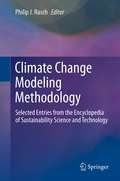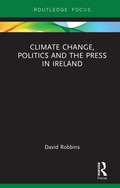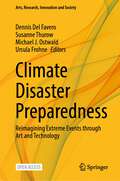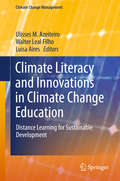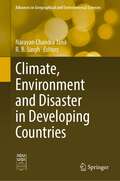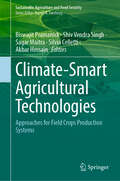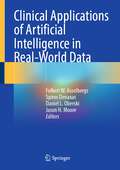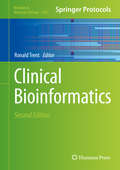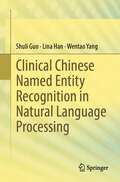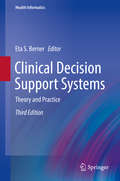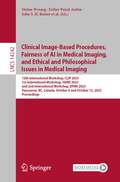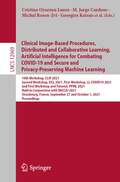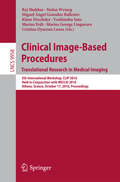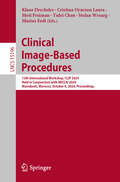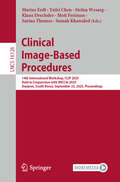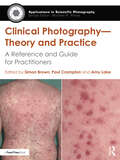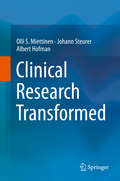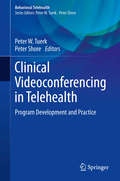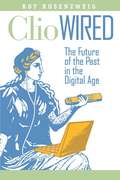- Table View
- List View
Climate Change Communication and the Internet
by Nelya Koteyko, Brigitte Nerlich and Iina HellstenThe volume provides a timely, state of the art collection of studies examining climate change communication in the era of digital media. The chapters focus on a broad range of topics covering various aspects of both practice and research in climate change communication, ranging from the use of online platforms, to blogs, and social networking sites. Climate change communication has increasingly moved into Internet-based forums, and this volume provides a comprehensive overview of research into Internet and climate change communication. The studies share valuable methodological insights in this relatively new field of research and shed light on the opportunities and challenges underlying the collection and analysis of online climate change-related data. This book was previously published as a special issue of Environmental Communication.
Climate Change Impact on Soil Erosion in Sub-tropical Environment: Application of Empirical and Semi-empirical Models (Geography of the Physical Environment)
by Subodh Chandra Pal Rabin ChakraborttyThis work focuses on the potential impact of climate change on soil erosion in a monsoon-dominated sub-tropical region. Water-induced soil erosion due to extreme rainfall during the monsoon period is a major problem worldwide, from different environmental and socio-economic perspectives. This study region covered (South Bengal) is one of the fertile agricultural belts that produces a good amount of produce and contributes to the country's GDP. However, the rate of agricultural output has decreased rapidly in recent times due to a decline in soil fertility. The monsoon-dominated sub-tropical region has unique characteristics in terms of seasonal temperature fluctuations and the availability of rainfall events. The sub-tropical region is densely populated, with the majority of the population relying on rain-fed agricultural production systems. The declining rate of agricultural production has also established that soil fertility is declining and soil erosion is increasing. Numerous studies show that soil erosion is the major cause of the region's rapidly increasing trend of land degradation. A homeostatic mechanism cannot replace soil erosion, and a gap arises between soil erosion and regolith formation. Extreme changes in land use and land cover, population growth and the lacking support for traditional agricultural practices and management practices can accelerate the rate of soil erosion and its associated reservoir sedimentation in most countries of the tropical and sub-tropical environment. Quantitative information with maximum possible accuracy through validation regarding soil loss can be an essential part of the appropriate and sustainable soil and water conservation planning. The precise aspects of modern day management strategies are soil erosion susceptibility mapping using empirical and semi-empirical models in a GIS platform or the use of probability statistics. The main objective of this work is to propose the most suitable development strategies considering the amount of soil erosion for the present and future periods. Extensive field research has been done to identify the support practice factor that the local stakeholders adopt in this region.
Climate Change Modeling Methodology: Selected Entries from the Encyclopedia of Sustainability Science and Technology
by Philip J. RaschThe Earth's average temperature has risen by 1.4°F over the past century, and computer models project that it will rise much more over the next hundred years, with significant impacts on weather, climate, and human society. Many climate scientists attribute these increases to the build up of greenhouse gases produced by the burning of fossil fuels and to the anthropogenic production of short-lived climate pollutants. Climate Change Modeling Methodologies: Selected Entries from the Encyclopaedia of Sustainability Science and Technology provides readers with an introduction to the tools and analysis techniques used by climate change scientists to interpret the role of these forcing agents on climate. Readers will also gain a deeper understanding of the strengths and weaknesses of these models and how to test and assess them. The contributions include a glossary of key terms and a concise definition of the subject for each topic, as well as recommendations for sources of more detailed information.
Climate Change, Politics and the Press in Ireland (Routledge Focus on Environment and Sustainability)
by David RobbinsMedia coverage of climate change has attracted much scholarly attention because the extent of such coverage has an agenda-setting effect and because the ways in which the coverage is framed can influence public perception of and engagement with the issue. However, certain gaps in our understanding of the processes whereby such coverage is produced remain. The competition among strategic actors to influence media framing strategies is poorly understood, and the perspectives of journalists and editors are largely absent from literature. With a view to advancing our understanding of the "frame competition" around climate change and to presenting the perspectives of journalists regarding climate change as a journalistic topic, this book presents an in-depth case history of media coverage of climate change in Ireland. First, the extent of media attention for climate change is established, and the way in which such coverage is framed is also examined. Through a series of interviews, including rare and privileged access to government ministers, their media advisors, and journalists and editors, the book uncovers the contest to establish a dominant framing. The main objective of this book is to advance our understanding of the contest to establish the dominant framing of climate change in the media discourse. Although focussed on Ireland, its conclusions are of value to those seeking to better understand the dynamics of media coverage of climate change in other contexts. This book will be of great interest to students and scholars of climate change, environmental policy, media and communication studies, and Irish politics.
Climate Disaster Preparedness: Reimagining Extreme Events through Art and Technology (Arts, Research, Innovation and Society)
by Michael J. Ostwald Ursula Frohne Dennis Del Favero Susanne ThurowAs a result of global warming, extreme events, such as firestorms and flash floods, pose increasingly unpredictable and uncertain existential threats, taking lives, destroying communities, and wreaking havoc on habitats. Current aesthetic, technological and scientific frameworks struggle to imagine, visualise and rehearse human interactions with these events, hampering the development of proactive foresight, readiness and response.This open access book demonstrates how the latest advances in creative arts, intelligent systems and climate science can be integrated and leveraged to transform the visualisation of extreme event scenarios. It reframes current practice from passive perception of pre-scripted illustrations to active immersion in evolving life-like interactive scenarios that are geo-located. Drawing on the multidisciplinary expertise of leaders in the creative arts, climate sciences, environmental engineering, and intelligent systems, this book examines the waysin which climate disaster preparedness can be reformulated through practices that address dynamic and unforeseen interactions between climate and human life worlds. Grouped into four sections (picturing, narrating, rehearsing, and communicating), this book maps this approach by exploring the emerging strengths and current limitations of each discipline in addressing the challenge of envisioning the unpredictable interaction of extreme events with human populations and environments. This book provides a timely intervention into the global discourse on how art, culture and technology can address climate disaster resilience. It appeals to readers from multiple fields, offering academic, industry and community audiences novel insights into a profound gap in the current knowledge, policy and action landscape.
Climate Literacy and Innovations in Climate Change Education: Distance Learning for Sustainable Development (Climate Change Management)
by Walter Leal Filho Ulisses M. Azeiteiro Luísa AiresThis book addresses the links between climate change and the threats it poses to sustainable development, from a distance education perspective. Discussing current trends and challenges in sustainable development education, climate literacy and innovations in climate change education, it contributes to the global debate on the implementation of education for sustainability. It also assesses the role that e-learning can play in this process, addressing pedagogical concepts as well as the wide range of technological options now available.
Climate, Environment and Disaster in Developing Countries (Advances in Geographical and Environmental Sciences)
by R. B. Singh Narayan Chandra JanaThe world is currently experiencing changes in climate and environment that often lead to natural disasters. Nearly three million people worldwide may have been killed in the past 20 years by natural disasters. In total, 90% of the natural disasters and 95% of all disaster-related deaths occur in the developing countries. Recently such problems have accelerated due to LULC change, biodiversity degradation, increased tourism, urbanization and climate change. This book, consisting of 27 chapters, explores the topics of climate, environment and natural disasters in developing countries. It is essential to discuss these diverse issues in the field of geography as it encompasses interdisciplinary topics. The range of issues on national, regional and local dimensions is not only confined to geography but also concerned to other disciplines as well. Therefore, this book is a valuable source for scientists and researchers in allied fields such as climatology, disaster management, environmental science, hydrology, agriculture, and land use studies, among other areas. Furthermore, this book can be of immense help to the planners and decision-makers engaged in dealing with the problems of climate, environmental change and natural disasters in developing countries.
Climate-Smart Agricultural Technologies: Approaches for Field Crops Production Systems (Sustainability Sciences in Asia and Africa)
by Akbar Hossain Biswajit Pramanick Shiv Vendra Singh Sagar Maitra Silvia CellettiThis book addresses the technologies that can be employed to tackle the challenges of global food security. Several recent studies have reported the significant impact of changing climate on the agricultural production, thus posing a challenge in achieving global food security. Thus, to mitigate these challenges there is an urgent need to develop approaches that may be helpful for the sustainability of food production. These approaches are based on three objectives: (i) sustainably increasing agricultural productivity to support equitable increases in farm incomes, food security, and development; (ii) adapting and building the resilience of food systems to climate change; and (iii), where possible, reducing GHGs emissions from agriculture. This book provides updated information for these climate-smart agricultural technologies that hold high potential to increase productivity, improve resilience, and provide efficient resource utilization. This book is a valuable resource for undergraduates, postgraduates, researchers, professors and policymakers in the field of agriculture, botany and agriculture extension functionaries.
Clinical Applications of Artificial Intelligence in Real-World Data
by Jason H. Moore Folkert W. Asselbergs Spiros Denaxas Daniel L. OberskiThis book is a thorough and comprehensive guide to the use of modern data science within health care. Critical to this is the use of big data and its analytical potential to obtain clinical insight into issues that would otherwise have been missed and is central to the application of artificial intelligence. It therefore has numerous uses from diagnosis to treatment. Clinical Applications of Artificial Intelligence in Real-World Data is a critical resource for anyone interested in the use and application of data science within medicine, whether that be researchers in medical data science or clinicians looking for insight into the use of these techniques.
Clinical Bioinformatics (Methods in Molecular Biology #1168)
by Ronald TrentIn Clinical Bioinformatics, Second Edition, leading experts in the field provide a series of articles focusing on software applications used to translate information into outcomes of clinical relevance. Recent developments in omics, such as increasingly sophisticated analytic platforms allowing changes in diagnostic strategies from the traditional focus on single or small number of analytes to what might be possible when large numbers or all analytes are measured, are now impacting patient care. Covering such topics as gene discovery, gene function (microarrays), DNA sequencing, online approaches and resources, and informatics in clinical practice, this volume concisely yet thoroughly explores this cutting-edge subject Written in the successful Methods in Molecular Biology series format, chapters include introductions to their respective topics, lists of the necessary materials and reagents, step-by-step, readily reproducible protocols, and notes on troubleshooting and avoiding known pitfalls. Authoritative and easily accessible, Clinical Bioinformatics, Second Edition serves as an ideal guide for scientists and health professionals working in genetics and genomics.
Clinical Chinese Named Entity Recognition in Natural Language Processing
by Shuli Guo Lina Han Wentao YangThis book introduces how to enhance the context capture ability of the model, improve the position information perception ability of the pretrained models, and identify and denoise the unlabeled entities. The Chinese medical named entity recognition is an important branch of the intelligent medicine, which is beneficial to mine the information hidden in medical texts and provide the medical entity information for clinical medical decision-making and medical classification. Researchers, engineers and post-graduate students in the fields of medicine management and software engineering.
Clinical Decision Support Systems: Theory and Practice (Health Informatics)
by Eta S. BernerBuilding on the success of the previous editions, this fully updated book once again brings together worldwide experts to illustrate the underlying science and day-to-day use of decision support systems in clinical and educational settings. Topics discussed include: -Mathematical Foundations of Decision Support Systems -Design and Implementation Issues -Ethical and Legal Issues in Decision Support -Clinical Trials of Information Interventions -Hospital-Based Decision Support -Real World Case Studies
Clinical Image-Based Procedures, Fairness of AI in Medical Imaging, and Ethical and Philosophical Issues in Medical Imaging: 12th International Workshop, CLIP 2023 1st International Workshop, FAIMI 2023 and 2nd International Workshop, EPIMI 2023 Vancouver, BC, Canada, October 8 and October 12, 2023 Proceedings (Lecture Notes in Computer Science #14242)
by Daniel Moyer Cristina Oyarzun Laura Stefan Wesarg Klaus Drechsler Marius Erdt Aasa Feragen Ben Glocker Veronika Cheplygina Enzo Ferrante Islem Rekik Yufei Chen Esther Puyol Antón John S. H. Baxter Roy Eagleson Andrew P. King Moti Freiman Melani Ganz-Benjaminsen Eikel PetersenThis book constitutes the refereed proceedings of the 12th International Workshop on Clinical Image-Based Procedures, CLIP 2023, the First MICCAI Workshop on Fairness of AI in Medical Imaging, FAIMI 2023, held in conjunction with MICCAI 2023, in October 2023, and the Second MICCAI Workshop on the Ethical and Philosophical Issues in Medical Imaging, EPIMI 2023.CLIP 2023 accepted 5 full papers and 3 short papers form 8 submissions received. It focuses on holistic patient models for personalized healthcare with the goal to bring basic research methods closer to the clinical practice.For FAIMI 2023, 19 full papers have been accepted from 20 submissions. They focus on creating awareness about potential fairness issues that can emerge in the context of machine learning. And for EPIMI 2023, 2 papers have been accepted from 5 submissions. They investigate questions that underlie medical imaging research at the most fundamental level.
Clinical Image-Based Procedures, Distributed and Collaborative Learning, Artificial Intelligence for Combating COVID-19 and Secure and Privacy-Preserving Machine Learning: 10th Workshop, CLIP 2021, Second Workshop, DCL 2021, First Workshop, LL-COVID19 2021, and First Workshop and Tutorial, PPML 2021, Held in Conjunction with MICCAI 2021, Strasbourg, France, September 27 and October 1, 2021, Proceedings (Lecture Notes in Computer Science #12969)
by Cristina Oyarzun Laura Raj Shekhar Stefan Wesarg Klaus Drechsler Marius Erdt Marius George Linguraru Daniel Rueckert M. Jorge Cardoso Shadi Albarqouni Spyridon Bakas Bennett Landman Nicola Rieke Holger Roth Daguang Xu Michal Rosen-Zvi Georgios Kaissis Yufei Chen Xiaoxiao Li Maria Gabrani Ender Konukoglu Michal Guindy Alexander Ziller Dmitrii Usynin Jonathan Passerat-PalmbachThis book constitutes the refereed proceedings of the 10th International Workshop on Clinical Image-Based Procedures, CLIP 2021, Second MICCAI Workshop on Distributed and Collaborative Learning, DCL 2021, First MICCAI Workshop, LL-COVID19, First Secure and Privacy-Preserving Machine Learning for Medical Imaging Workshop and Tutorial, PPML 2021, held in conjunction with MICCAI 2021, in October 2021. The workshops were planned to take place in Strasbourg, France, but were held virtually due to the COVID-19 pandemic.CLIP 2021 accepted 9 papers from the 13 submissions received. It focuses on holistic patient models for personalized healthcare with the goal to bring basic research methods closer to the clinical practice. For DCL 2021, 4 papers from 7 submissions were accepted for publication. They deal with machine learning applied to problems where data cannot be stored in centralized databases and information privacy is a priority. LL-COVID19 2021 accepted 2 papers out of 3 submissions dealing with the use of AI models in clinical practice. And for PPML 2021, 2 papers were accepted from a total of 6 submissions, exploring the use of privacy techniques in the medical imaging community.
Clinical Image-Based Procedures. Translational Research in Medical Imaging: 5th International Workshop, CLIP 2016, Held in Conjunction with MICCAI 2016, Athens, Greece, October 17, 2016, Proceedings (Lecture Notes in Computer Science #9958)
by Cristina Oyarzun Laura Raj Shekhar Stefan Wesarg Miguel Ángel González Ballester Klaus Drechsler Yoshinobu Sato Marius Erdt Marius George LinguraruThis book constitutes the revised selected papers from the 5th International Workshop on Clinical Image-Based Procedures, CLIP 2016, held in conjunction with MICCAI 2016 in Athens, Greece, in October 2016. The 10 papers presented in this volume were carefully reviewed and selected from 16 submissions. Specific topics include various image segmentation and registration techniques, applied to various parts of the body. They range from interventional planning to navigation of devices and navigation to the anatomy of interest. Clinical applications cover the skull, the cochlea, cranial nerves, the aortic valve, wrists, and the abdomen, among others.
Clinical Image-Based Procedures. Translational Research in Medical Imaging: Second International Workshop, CLIP 2013, Held in Conjunction with MICCAI 2013, Nagoya, Japan, September 22, 2013, Revised Selected Papers (Lecture Notes in Computer Science #8361)
by Marius Erdt, Marius George Linguraru, Cristina Oyarzun Laura, Raj Shekhar, Stefan Wesarg, Miguel Angel González Ballester and Klaus DrechslerThis book constitutes revised selected papers from the International Workshop on Clinical Image-Based Procedures, CLIP 2013, held in conjunction with MICCAI 2012 in Nagoya, Japan, in September 2013. The 19 papers presented in this volume were carefully reviewed and selected from 26 submissions. The workshop was a productive and exciting forum for the discussion and dissemination of clinically tested, state-of-the-art methods for image-based planning, monitoring and evaluation of medical procedures.
Clinical Image-Based Procedures: 11th Workshop, CLIP 2022, Held in Conjunction with MICCAI 2022, Singapore, September 18, 2022, Proceedings (Lecture Notes in Computer Science #13746)
by Cristina Oyarzun Laura Raj Shekhar Stefan Wesarg Klaus Drechsler Marius Erdt Marius George Linguraru Yufei ChenThis book constitutes the proceedings of the 11th Workshop on Clinical Image-Based Procedures, CLIP 2022, which was held in conjunction with MICCAI 2022, in Singapore in September 2022. The 9 full papers included in this book were carefully reviewed and selected from 12 submissions. They focus on the applicability of basic research methods in the clinical practice by creating holistic patient models as an important step towards personalized healthcare.
Clinical Image-Based Procedures: 13th International Workshop, CLIP 2024, Held in Conjunction with MICCAI 2024, Marrakesh, Morocco, October 6, 2024, Proceedings (Lecture Notes in Computer Science #15196)
by Cristina Oyarzun Laura Stefan Wesarg Klaus Drechsler Marius Erdt Yufei Chen Moti FreimanThis book constitutes the proceedings of the 13th Workshop on Clinical Image-Based Procedures, CLIP 2024, held in conjunction with the 27th International conference on Medical Image Computing and Computer Assisted Intervention, MICCAI 2024, in Marrakesh, Morocco in October 2024. The 9 full papers included in this book were carefully reviewed and selected from 11 submissions. They deal with Clinical image-based procedures, focusing on holistic patient models as an important step towards personalized healthcare.
Clinical Image-Based Procedures: 14th International Workshop, CLIP 2025, Held in Conjunction with MICCAI 2025, Daejeon, South Korea, September 23, 2025, Proceedings (Lecture Notes in Computer Science #16126)
by Stefan Wesarg Klaus Drechsler Marius Erdt Yufei Chen Moti Freiman Sarina Thomas Samah KhawaledThis book constitutes the proceedings of the 14th International Workshop on Clinical Image-Based Procedures, CLIP 2025, held in conjunction with the 28th International Conference on Medical Image Computing and Computer Assisted Intervention, MICCAI 2025, held in Daejeon, South Korea, on September 23, 2025. The 11 full papers included in this book were carefully reviewed and selected from 17 submissions. The workshop focuses on translational research and provides a forum for scientific work applied to clinical practice.
Clinical Information Systems: Overcoming Adverse Consequences
by Dean F. Sittig Joan S. AshAs the number of healthcare organizations beginning to implement clinical information systems grows, the number of unanticipated and unintentional consequences inevitably increases as well. While existing research suggests that much good can come from clinicians entering orders directly, errors or other unintended consequences related to technology may arise. Ideal for both clinicians and information technology professionals, Clinical Information Systems: Overcoming Adverse Consequences helps fledgling organizations better prepare for the inevitable challenges and obstacles they will face upon the implementation of such systems. Based on the research and findings from the Provider Order Entry Team from the Oregon Health & Science University, this book discusses the nine categories of unintended adverse consequences that occurred at many of the leading medical centers during their implementation and maintenance of a state-of-the-art clinical information system. It goes on to present the best practices they identified to help organizations overcome these obstacles.
Clinical Photography — Theory and Practice: A Reference and Guide for Practitioners (Applications in Scientific Photography)
by Simon Brown Paul Crompton Amy LakeThis is an authoritative and comprehensive reference for understanding clinical photography and improving the reader's ability to hone their skills and knowledge.The book first explores the rationale for clinical photography before going on to provide a practical guide to equipment selection, standardized techniques and digital workflows in a range of settings, from the professional studio to the DIY enthusiast, whilst also including telemedicine.Written and edited by three of the UK’s most experienced and qualified clinical photographers, with additional chapters written by other specialists, it is richly illustrated with numerous example images and suggested protocols and covers basic photographic theory, suitable equipment, digital image workflow and a major chapter on standardized representational photography, the cornerstone of professional clinical photography.Some medical specialties are covered in detail, including dermatology, dental and oral medicine, pediatrics, orthopedics, telemedicine and photography in surgery and the operating room. As well as a practical guide to clinical photography, the book also discusses the legal, moral and ethical contexts within which photography in medicine operates and, for the first time, explores the societal, cultural and religious factors for practicing in today’s digitally literate, multicultural world.This book will provide a valuable resource for biomedical photography students, practitioners and clinicians interested in developing their photography skills and applying them to medicine.
Clinical Research Transformed
by Olli S. Miettinen Johann Steurer Albert HofmanIn this Information Age, the practices of clinical medicine should no longer be based on what clinical doctors actively know. Rather, all of the importantly practice-relevant knowledge should not only already exist but also be codified in cyberspace, in directly practice-guiding 'expert systems' -- for the benefit of both doctors and patients everywhere. Each of these systems (discipline-specific) would, prompted by a particular type of case presentation, present the doctor a questionnaire specific to cases of the type at issue, and document the doctor's answers to the questions. If at issue would be a case of complaint about a (particular type of) sickness, the system would translate the resulting diagnostic profile of the case into the corresponding probabilities of the illnesses to be considered. Similarly, if at issue would be an already-diagnosed case of a particular illness, the system would ask about, and record, the relevant elements in the prognostic profile of the case and then translate this profile into the probabilities of various outcomes to be considered, probabilities specific to the choice of treatment and prospective time in addition to that profile. And besides, these systems would analogously address the causal origin -- etiogenesis -- of cases of particular types of illness. While the requisite knowledge-base for these systems -- notably for the probabilities in them -- has not been addressed by such 'patient-oriented' clinical research as has been conducted (very extensively) up to now, this book delineates the nature of the suitably-transformed research (gnostic). The critically-transformative innovation in the research is the studies' focus on Gnostic Probability Functions -- dia-, etio-, and prognostic -- in the framework of logistic regression models. This book also presents a vision of how this critically-transformative research would most expeditiously be provided for and also conducted, among select sets of academic teaching hospitals.
Clinical Videoconferencing in Telehealth: Program Development and Practice (Behavioral Telehealth)
by Peter W. Tuerk Peter ShoreResearch findings and dissemination are making healthcare more effective. Electronic health records systems and advanced tools are making care delivery more efficient. Legislative reforms are striving to make care more affordable. Efforts still need to be focused on making healthcare more accessible. Clinical Videoconferencing in Telehealth takes a comprehensive and vital step forward in providing mental health and primary care services for those who cannot make traditional office visits, live in remote areas, have transportation or mobility issues or have competing demands. Practical, evidence-based information is presented in a step by step format at two levels: for administrators, including information regarding selecting the right videoconferencing technology, navigating regulatory issues, policy temples, boilerplate language for entering into care agreements with other entities and practical solutions to multisite programming; and for clinicians, including protocols for safe, therapeutically sound practice, informed consent and tips for overcoming common technical barriers to communication in clinical videoconferencing contexts. Checklists, tables, templates, links, vignettes and other tools help to equip professional readers for providing safe services that are streamlined and relevant while avoiding guesswork, false starts and waste. The book takes a friendly-mentor approach to communication in areas such as: Logistics for administrators: Clinical videoconferencing infrastructures and technologies Policy development, procedures and tools for responsible and compliant programming Navigating issues related to providing services in multiple locations Protocols for clinicians: The informed consent process in clinical videoconferencing Clinical assessment and safety planning for remote services Minimizing communication disruption and optimizing the therapeutic alliance Clinical Videoconferencing in Telehealth aptly demonstrates the promise and potential of this technology for clinicians, clinic managers, administrators and others affiliated with mental health clinical practices. It is designed to be the comprehensive "one-stop" tool for clinical videoconferencing service development for programs and individual clinicians.
Clinical and Biomedical Engineering in the Human Nose: A Computational Fluid Dynamics Approach (Biological and Medical Physics, Biomedical Engineering)
by Jiyuan Tu Kiao Inthavong Narinder Singh Eugene WongThis book explores computational fluid dynamics in the context of the human nose, allowing readers to gain a better understanding of its anatomy and physiology and integrates recent advances in clinical rhinology, otolaryngology and respiratory physiology research. It focuses on advanced research topics, such as virtual surgery, AI-assisted clinical applications and therapy, as well as the latest computational modeling techniques, controversies, challenges and future directions in simulation using CFD software. Presenting perspectives and insights from computational experts and clinical specialists (ENT) combined with technical details of the computational modeling techniques from engineers, this unique reference book will give direction to and inspire future research in this emerging field.
Clio Wired: The Future of the Past in the Digital Age
by Roy RosenzweigIn these visionary essays, Roy Rosenzweig charts the impact of new media on teaching, researching, preserving, presenting, and understanding history. Negotiating between the "cyberenthusiasts" who champion technological breakthroughs and the "digitalskeptics" who fear the end of traditional humanistic scholarship, Rosenzweig re-envisions academic historians' practices and professional rites while analyzing and advocating for amateur historians' achievements. While he addresses the perils of "doing history" online, Rosenzweig eloquently identifies the promises of digital work, detailing innovative strategies for powerful searches in primary and secondary sources, the increased opportunities for dialogue and debate, and, most of all, the unprecedented access afforded by the Internet. Rosenzweig draws attention to the opening up of the historical record to new voices, the availability of documents and narratives to new audiences, and the attractions of digital technologies for new and diverse practitioners. Though he celebrates digital history's democratizing influences, Rosenzweig also argues that we can only ensure the future of the past in this digital age by actively resisting the efforts of corporations to put up gates and profit from the Web.


